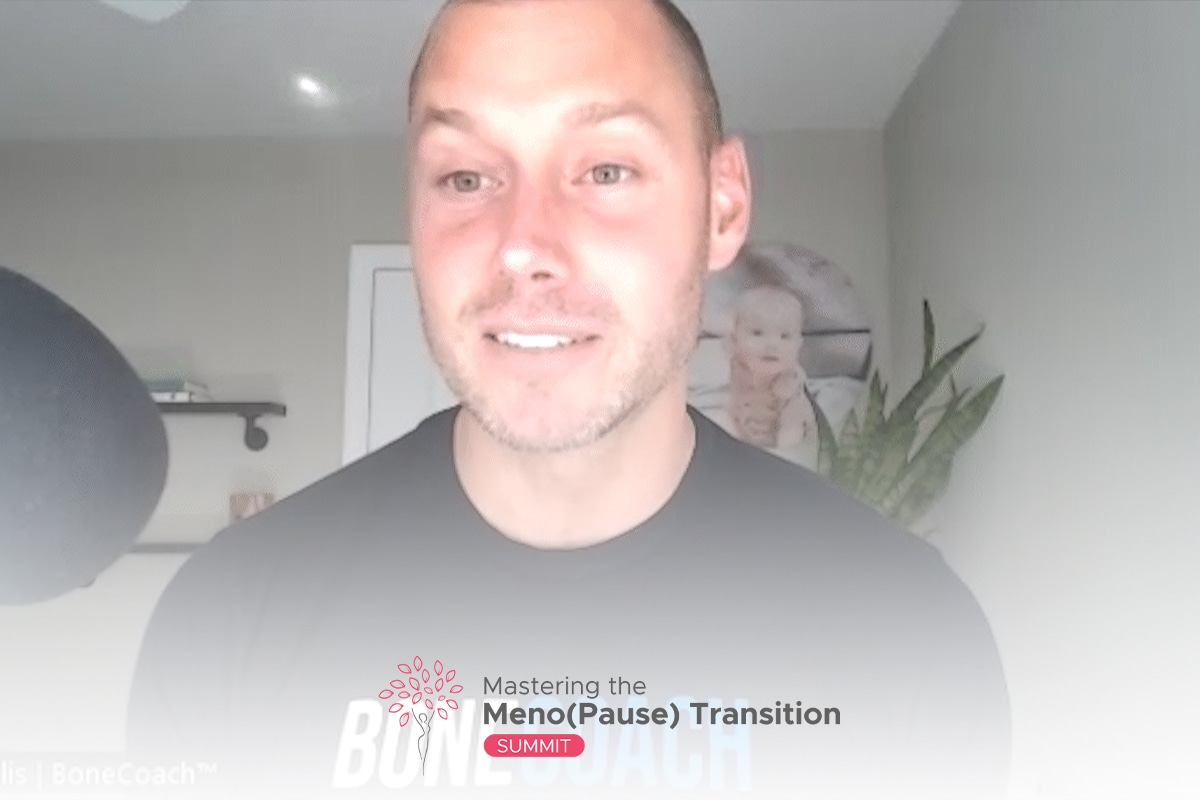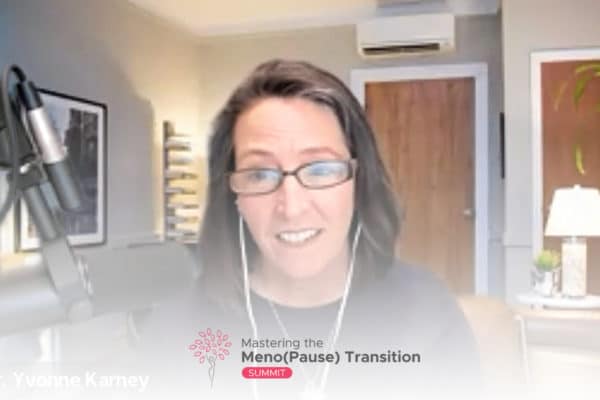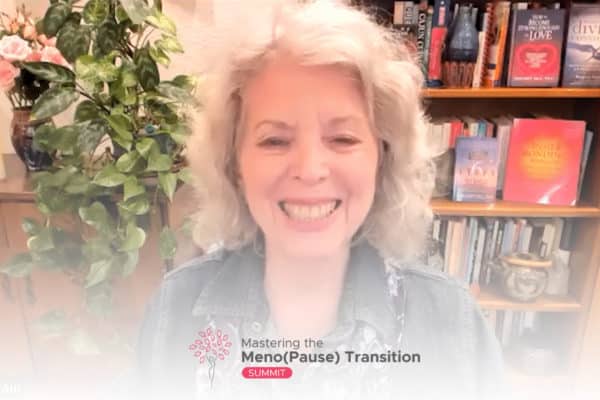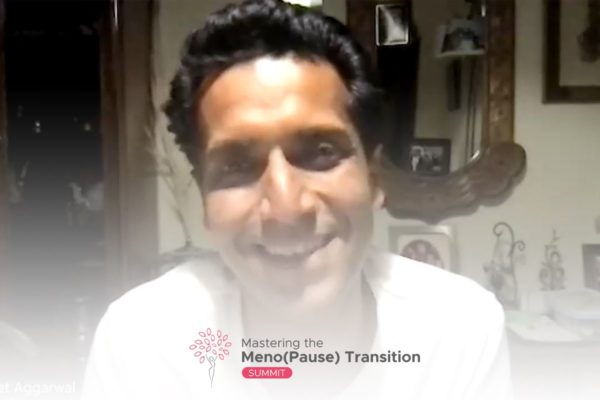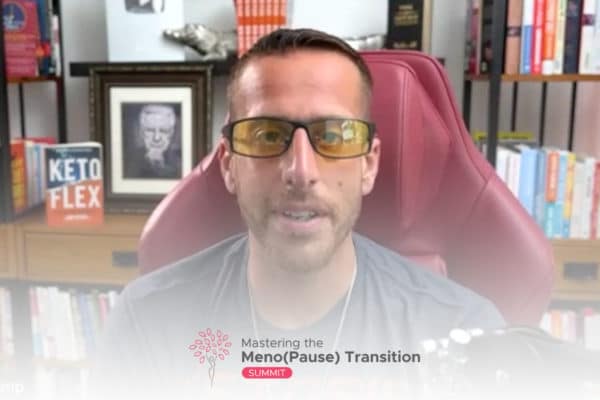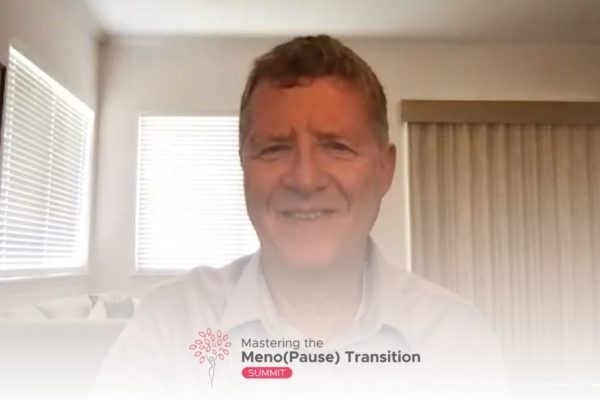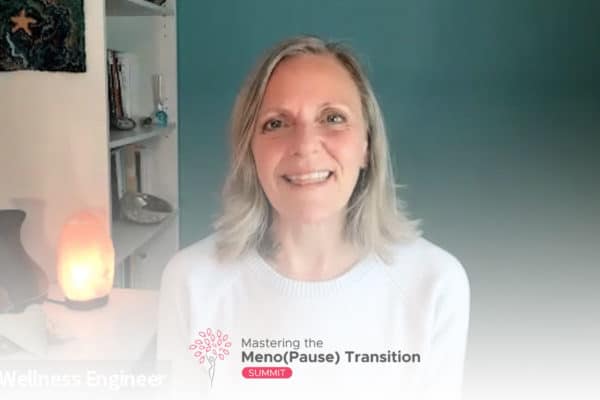Join the discussion below
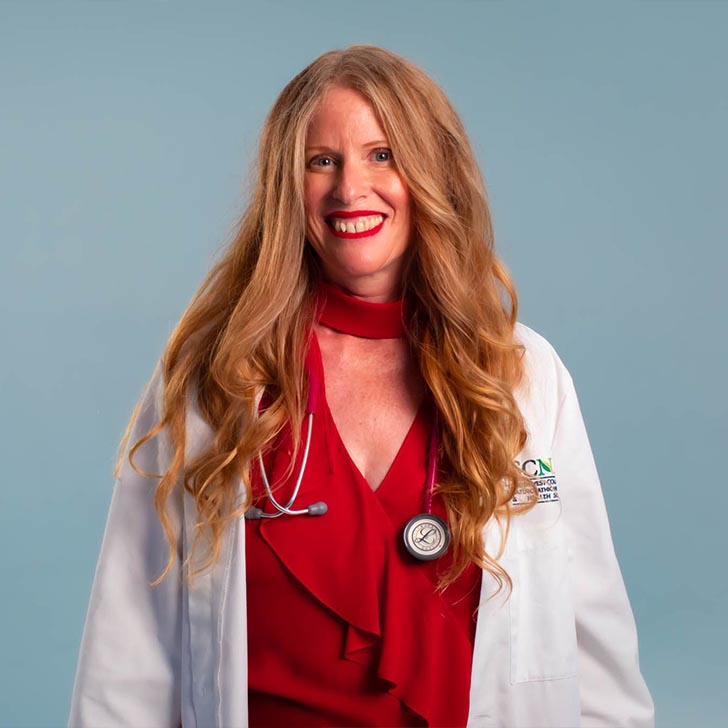
Dr. Sharon Stills, a licensed Naturopathic Medical Doctor with over two decades of dedicated service in transforming women’s health has been a guiding light for perimenopausal and menopausal women, empowering them to reinvent, explore, and rediscover their vitality and zest for life. Her pioneering RED Hot Sexy Meno(pause) Program encapsulates... Read More
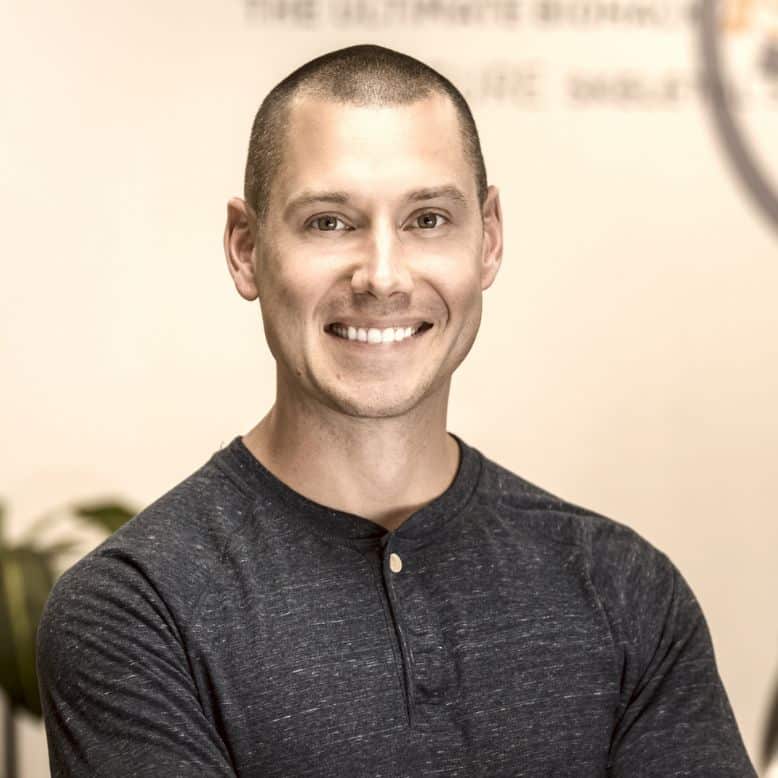
Kevin Ellis, better known as Bone Coach™, is a certified Integrative Nutrition health coach, podcaster, YouTuber, bone health advocate, and the founder of BoneCoach.com. After an osteoporosis diagnosis in his early 30s, he realized just how challenging it can be for the average person to make sense of what needs... Read More
- What is the connection between gut health and bone health?
- Is there a perfect diet for osteoporosis?
- Any specific foods that can be a helpful addition to a bone-healthy plan?
Dr. Sharon Stills
Hi, everyone. Welcome back to “Mastering the Menopause Transition Summit”. I’m your host, Dr. Sharon Stills, and today is the day we’re gonna talk about them bones. I know that is something that’s on all of your minds. As we age, we worry about osteopenia and osteoporosis. And today I have Kevin Ellis with me, who’s better known as the BoneCoach. He came properly dressed, and he is a certified integrative nutrition health coach. He’s a podcaster, a YouTuber, a bone health advocate. He’s the founder of Bonecoach.com. He’s one of the sponsors of our summit, and he actually had an osteoporosis diagnosis in his early 30s. And he realized just how challenging it can be for the average person to make sense of what needs to be done to improve, and how to move forward confidently with the Stronger Bones plan. So today, not only has he transformed his own health and made continued progress on his own journey, he’s now dedicated his life to helping women with osteopenia and osteoporosis gain clarity and confidence that improvement is actually possible. He has a unique three-step process, world-class coaching programs. I’m so excited, I can’t talk, I’m stumbling on my words. And his team of credentialed experts have helped people in over 1,500 plus cities around the world get confident in their Stronger Bones plan. And I’ve brought him here for you so we can have this super important conversation, and you can learn what you need to do to help your bones. So welcome to the summit, thanks for being here.
Kevin Ellis
Sharon, thanks so much for having me. It’s great to be here.
Dr. Sharon Stills
Yeah, such an important topic. One I deal with with my patients every day, and something that’s on everyone’s mind. So I actually didn’t know that you had your, we always think of osteoporosis as we own that, the women own that, but tell us your story.
Kevin Ellis
Yeah, so it’s kind of shocking, right, when you see a younger male or hear about a younger male having been diagnosed with osteoporosis at a young age. And for me, it was equally as shocking. At the time that I was diagnosed, I had all these other health issues that were taking place. I had poor sleep, high stress, fatigue. I had hormone issues and digestive distress, digestive issues. And then all my health issues came to fruition and I was diagnosed with celiac disease, and then subsequently diagnosed with osteoporosis. And celiac disease, for those who are not familiar, that’s where the ingestion of gluten damages the villi in the small intestine, prevents you from absorbing nutrients. Those nutrients like calcium and vitamin D and phosphorus, super important for your bones. I was having a hard time absorbing those nutrients, and my body still needed those nutrients to serve, to execute its daily functions. And those nutrients were being raked from my bones. And that is what ended up contributing to osteoporosis at such an early age for me. And I was completely shocked at that point in time because I had young kids that were on the way, that I was just worried I wasn’t gonna be able to be there for them. And I set down this path of how do I figure this out? I have to make improvements. I have to improve my health. My father, he passed away at a really, really young age. When I was, my mother was five months pregnant with me, my father was told he had cancer, and two months after I was born, he passed away.
Dr. Sharon Stills
Aw.
Kevin Ellis
So I had this fear growing up that I was gonna follow down that path. And when we had kids on the way, and I was told I had osteoporosis, I was like, oh my gosh, I’m living this nightmare that I never wanted to live. So I had a really strong reason to figure this out, so I went down the path of reading, and research, and consulting with experts, and spending a lot of money, and trying to figure all these things out. And I started making progress, was improving my health, improving my bones. And I got to the point where I realized, in this journey, it is not the average 30-year-old male that’s trying to figure this out. It’s the average woman who is 45, 65 plus, that has osteopenia, osteoporosis diagnosis, and they’re presented with four things. Take your calcium, vitamin D, go for a walk, and take a bone drug. And that is woefully inadequate. And that’s really the reason why I set down this path to create BoneCoach, became a coach, built out a team, developed these programs, and created Bonecoach.com, because this was such an important area that I knew I could affect some great change in. So that was really my passion story leading into this whole journey.
Dr. Sharon Stills
Wow. I’m sorry of the loss of your dad at such a young age, but such a good reminder that we are not, we are not our family history necessarily, that we change the way our genetics express themselves. I see that all the time in practice where patients get really nervous ’cause they’re turning 53 and that’s the time their mom died, and that we have the power to make differences. And your story is so inspiring that from a serious condition, you totally turned it into rainbows, and happiness, and health and benefit for the world. So that’s super. So, all right, let’s do this, now that we know why, ’cause I would imagine some women are like, well, why is this man gonna tell me about my bones? This is a woman thing.
Kevin Ellis
Oh yeah! Trust, me, I get that all the time. Once people come into like our ecosystem and they understand me a little bit and where I come from, they start to come around, they realize I’m pretty knowledgeable in this area.
Dr. Sharon Stills
Yeah, you’re in the trenches. You are there. And that is common with celiac disease and gluten. So that’s just a good connection for women to have. So let’s talk about, just in case most people have an idea of osteopenia, osteoporosis, but let’s hear exactly what is it, just so we all start out on the same foundation of understanding what this actually is.
Kevin Ellis
Absolutely, I think that’s a great place to start. So osteoporosis literally means porous bone, and it’s a condition that’s characterized by either not enough bone formation, excessive bone loss, or it’s a combination of those things. And in osteoporosis, both your bone density and your bone quality are reduced. So the way you find out you have osteoporosis is through what’s called a DEXA scan. Dual Energy X-ray Absorb geometry. It’s a painless test, kind of like an x-ray, very low levels of radiation. You go, you lay down on the machine, the machine does a scan, and it tells you your bone mineral density, the actual mineral content of your bone. And then what it does is it generates a score, and that score is called a T-score. And the T-score is telling you how much your bone mass differs from the bone mass of a healthy, average, approximately 30-year-old adult.
And if you’ve got a T-score of plus one or minus one or zero, that’s an indicator that your bones are normal and healthy, right? If you’ve got a score of negative one to negative 2.5, that’s considered osteopenia, or low bone mass. And that’s like a precursor to osteoporosis. And if you have negative 2.5 or lower, negative 2.6, negative 2.7, so on and so forth, that’s considered osteoporosis. And the greater that negative number becomes, the more severe the osteoporosis, and the greater the risk of fracture. So most women are, you’re not getting these scans done, and usually, in my opinion, until it’s too late. I would prefer to see people get them done, baselines done in their 30s and their 40s, but a lot of times they’re not getting ’em done until their 50s, their 60s, as a check in the box, their doctor orders them, they get this scan done, and then they realize, oh my gosh, I have low bone density, what do I have to do now? And that’s kind of the starting point, usually where I’m meeting people at is right at the point of diagnosis.
Dr. Sharon Stills
Right. I think that’s really important, if you are gonna use DEXA as a way to measure, then you should be doing your own, because everyone has different bone structure and it’s inaccurate if you’re all of a sudden showing up at 50 or 60 and doing a scan, and now you’re being measured against this amorphous average 30-year-old. And so it can be really misleading. And so in everything, it’s always good to get your own thumbprint of what you are, so you can measure against yourself. It’s why I have my patients get their children start doing blood levels and things, just so we can be tracking and seeing. It’s much easier to prevent or to understand if we have something to look back at. So yes.
Kevin Ellis
You’re speaking my language. You’re speaking my language here. Okay, so you actually, you just touched on something though, which is great, right? Just because you get a bone density scan, that’s not the whole part of the picture, right? When you get your bone density scan, that’s telling you your bone density. The measure of how much bone you have. The actual mineral content of your bone. But there’s another part of that picture you probably don’t have, and that’s your bone quality. And that’s how that bone is organized. The micro architecture, the structural integrity of that bone. Bone density and bone quality combine to create bone strength.
So a lot of times you only have part of the picture. Now, to get that full picture, that full bone quality picture, there is an add-on software to a bone density scan called a TBS, a Trabecular Bone Score. And you can ask for that, and there’s also, you can go look it up and see if there’s one in your area, that may or may not have it. But if you can get those done at the same time, you can leave with a measure of your bone density and your bone quality, and a better representation of your bone strength. Because bone quality is really, really, really important. I’ve seen people that have been in the negative threes with their bone density, that have never fractured, right? I’ve seen people that have been in the negative ones, and what would technically be considered osteopenia, that have fractured multiple times. And a lot of the reason for that is, is that bone quality piece.
Dr. Sharon Stills
Exactly.
Kevin Ellis
So super, super important part of the picture.
Dr. Sharon Stills
Super, super important. And while we’re just talking about testing, from a functional perspective, N-Telopeptide or urinary, can you speak to that also?
Kevin Ellis
Absolutely. So I love this question, because it goes a little bit further than just taking the bone density scan as that’s the final result, here’s your medication, because there’s still more to the picture that we need to understand. And you don’t know, for example, if when you get that bone density scan, if you are still actively losing bone right now, right? And you have to understand that before you move forward. And I always tell people to imagine your body is like a bucket, right? And the water within that bucket represents your bone mineral density, the measure of how much bone you have. Imagine that bucket has a tiny hole in it with a very tiny leak. And over time, over years and years, that water level gets lower and lower and lower. That’s what’s happening with your bone density, right? Until one day you go and you get that scan, and you realize you have low bone density. But when you get that scan, you don’t know if there are still holes in your bucket. If your bucket was just not full to begin with. And you have to make, you have to understand those things before you start jumping into a medication. So in terms of understanding if you’re actively losing bone, there’s a test called the C-Telopeptide test. A Serum CTX. That is a great measure for bone resorption, bone breakdown. There’s also NTX, N-telopeptide.
That’s another way to look at whether your bones are actively breaking down or not. Because if that activity level is elevated, that can be an indicator of active bone loss. At the same time that you’re looking at the activity level of bone loss or bone resorption, you need to be looking at bone formation markers too. The bone formation markers are P1NP, Procollagen Type 1 N-terminal propeptide, that’s a good one. Osteocalcin is another one. And bone-specific alkaline phosphatase. That gives you a really good picture, and if you, I would always suggest, when you get a bone density scan, try to get as many of those as you possibly can. At the very least, get your C-Telopeptide, or urine NTX or something like that, at the very least. But if you can get more of those for your baseline, get ’em, because that’s what we need to monitor future changes from, three to six months down the road, especially if somebody is still actively losing bone, and something’s contributing to that loss. In three to six months, we need to see if we’re addressing those root cause issues, and if those markers are improving.
Dr. Sharon Stills
That’s great, so now you have it, like you have the information and you have why, so you can go to your physician. And if, in hearing why you want this and why they’re important, your physician doesn’t wanna run these levels for you, time to go find a different physician, right? Like-
Kevin Ellis
True. Absolutely.
Dr. Sharon Stills
I run these levels on patients and I’m always open. If someone comes to me with something I’m like oh, I’ll just add that into my blood levels that I run.
Kevin Ellis
So why might a physician not wanna run those tests? Well, let’s see. If you’re going to your general practitioner, for example, and they’ve just gotten your DEXA scan results back and they’re giving you the results and they just say here’s your Fosamax, well that might not obviously be the right approach moving forward, then you ask for some of these bone turnover markers, and they say, no, they’re not gonna order them for you, part of the reason may be because they’re not familiar with their interpretation. If a physician orders a test and they don’t know how to interpret that test, it could create a liability for them also. So what they may do is they may try to refer you out to an endocrinologist, who then may or may not actually order that test for you. So I like what you’re saying here, Dr. Sharon, because in these situations, if you have somebody that has a functional background or understands that side of the picture, they’re more likely gonna be able to order those tests and understand the interpretation of them.
Dr. Sharon Stills
Yeah, and you could tell your doctor that they could get educated and learn how to interpret it. I mean, I am constantly on the phone with labs when I’m running new levels, learning how to interpret them. So it just takes a little extra effort on the doctor’s part. And so you wanna have a team who is willing to put in the extra effort for you. So, let’s talk about, you mentioned Fosamax. So before we get to root causes, let’s just have the pharmaceutical conversation.
Kevin Ellis
Yeah, for sure.
Dr. Sharon Stills
What is the standard treatment protocol, and why is it not acceptable?
Kevin Ellis
Yeah, so standard treatment protocol is kind of like I outlined at the beginning. Calcium, vitamin D, go for a walk, take a bone drug. Now, when you’re presented different options for bone medications, and it’s not just Fosamax, there are a lot of other options for bone medications, and there are different use situations where a drug might be used, or maybe better to use a specific medication. But what I always caution people with is these drugs are not like taking an aspirin. They have a dramatic effect on bone physiology. So you really have to understand the short and long-term implications of use, and things like that. So there are two categories of these medications. There are antiresorptives, which include bisphosphonates and RANK Ligand inhibitors. So bisphosphonate would be like Fosamax. RANK Ligan inhibitor would be like Prolia. And then there’s another category of medications called anabolics.
And the antiresorptives, their whole job is to help slow down the activity level of cells that break down bone, okay. And the reason why that could be a challenge, and why it may not be the most effective thing long-term, is yes, there are short and long-term implications and side effects and uses with those drugs. But, probably the biggest concern is that as you’re going about your daily life, and this is normal for every single person, whether they have osteopenia or osteoporosis or not, you’re going, you’re doing activities. You’re starting to get these little micro cracks and fractures, that your body, that’s just normal and natural for all of us. And then what happens is you have these cells within the bone that say hey, we’re starting to get these little micro cracks. We need to build stronger bone, right? So you have these bone cells that come in called osteoclast, and they scoop out that damaged bone. And then these next cells come in called osteoblasts, and they fill in stronger, healthier bone. That’s normal for every single person, right? You need those cells to come in and scoop out the damaged stuff, so the new, fresher, stronger bone can be laid down. When you’re taking one of these medications that slows down the activity level of cells that break down bone, you’re gonna continue to accumulate those tiny little micro cracks and fractures as you go about doing your daily activities. But if you slow down the activity level of those cells too much, you can’t then scoop out that damaged, worn, weakened bone. And you won’t have that new bone come in and fill in later.
So what happens is, five years down the road, three years down the, whatever it is, you can start to accumulate more of those, and that’s gonna lead to weaker bones long-term. So that is one of the biggest concerns with those medications. That’s for bisphosphonates. And I’m not saying that in every situation that might not be helpful for some people. There may be, I see smaller percentages of people where that may be necessary and important, but the vast majority, there’s so much more to be done before you even do something, or get to that point. So that’s one of those categories of medications. The other one are anabolics. And a lot of times in anabolic medication, they’re designed to help build bone and build it faster.
And the reason why those drugs might be important is because if somebody is coming in and they have poor quality bone, and they’ve maybe fractured multiple times, that is usually gonna be a situation where a physician is recommending an anabolic medication. And if you take an anabolic medication, those drugs usually have a length of time that you can use them for, 13 months, two years, there’s like a maximum limit you would wanna use those medications. But what a lot of them don’t tell you is you have to then follow that medication with an antiresorptive medication. So there are just a lot of things, there’s a lot of education that has to be done before you consider going that route. So I would say 85 to 90% of the people we work with that I talk to, there’s a lot that can be done before you would ever even get to that point or consider that point. So.
Dr. Sharon Stills
Absolutely, I’ll up the anti to 100%. I never put patients on those meds. I mean, you did a good job of explaining why they don’t really work very well, and also they just have a myriad of side effects that are nasty. And so we’re trying to solve a problem, we’re not really even solving it, and then we’re creating a whole nother host of problems. So, I’m sure some of you who are listening are on these meds, and I’m not saying to stop them today. But, this is a wake up call. There’s other ways and you can go on a journey of figuring out how to get off of those and what you need to do. So let’s talk about some root causes. Like why does this occur to begin with?
Kevin Ellis
Well, so let’s talk about, there are different types of osteoporosis, right? So there’s primary osteoporosis. That occurs as a result of a decrease in estrogen in postmenopausal women. Estrogen has a protective effect on bone. When estrogen levels decrease, as they do during menopause, that causes an increase in the activity level of cells that are gonna break down bone, right? So that’s primary osteoporosis. But then we have a whole nother cause of osteoporosis, which is secondary osteoporosis. And that’s where bone loss and osteoporosis occurs as a result of behaviors, disorders, diseases, medications, and different conditions. And that’s the category I fell into, and a lot of times that’s the category people, ’cause we’ve worked with people that have anywhere from their late 20s to their mid-90s. And so a lot of times it’s not just hormones that are the contributing factors. So we don’t wanna make an assumption that, oh, it’s just hormones, and move forward. You have to rule out the root cause issues too. So we can, in terms of the actual root cause issues, let’s get into some of those. So there are multiple different ones. Medications. I’ll talk about some of the more common medications that contribute to bone loss.
Glucocorticoids. So these are steroid medications that are designed to suppress inflammation. And what they’re doing is they’re mimicking natural steroid hormones produced by your body. They’re often used to treat things like asthma, autoimmune diseases like rheumatoid arthritis. Prednisone and cortisone, those are some of the big names there, right? Bone loss is a common side effect with those medications, and that’s for a couple of different reasons. The first one is that it’s reducing the intestinal absorption of calcium, and it’s increasing their urinary excretion of calcium. So you’ve got a calcium deficit. Primary mineral constituent of your bones is calcium. The other part of this is glucocorticoids, they’re directly acting on those bone cells that break down bone, the osteoclast, and they’re increasing their lifespan, which is gonna reduce your bone density. So if somebody is on those medications, just know that bone loss is gonna be a side effect of those medications. SSRIs, selective serotonin reuptake inhibitors. That’s a class of drugs that are typically used as antidepressants.
There was a review in 19 studies on the effect of SSRIs on bone, that indicate they have a negative effect on bone marrow density, and increase the risk of fracture. Right? So that’s an important one too. And then antacids. This is a big one that a lot of people, a lot of people aren’t aware of. So a lot of times, when someone has heartburn, right, or acid reflux, what are they taking? They’re taking Tums. They’re taking some kind of something to reduce that stomach acid. But usually they have too little stomach acid that they’re trying to suppress. And the drugs that they’re taking are proton pump inhibitors like omeprazole, Nexium, Prevacid, H2 receptor antagonist drugs like ranitidine or Zantac. I took those for a number of years, and I was suppressing the little stomach acid I did have. And the reason that’s a problem is because you need stomach acid to properly break down and extract nutrients from your food. Amino acids, calcium, magnesium, iron, B12, all those nutrients are nutrients that you need. And if you’re suppressing that stomach acid and you’ve got low stomach acid, that’s gonna be an issue for you. You’re gonna have a hard time with those nutrients. So that can be something that contributes to bone loss and osteoporosis long-term also.
Dr. Sharon Stills
I’m loving this interview. You’re just hitting everything. I have to tell you, one of the very first things I do is check hydrochloric acid, stomach acid. And most people, it used to be, I mean, I’ve been practicing for over 20 years, so used to be, it was like over the age of 30, 35, it started declining. It’s declining now, I have children in my practice who have no stomach acid, and it leads to asthma and it leads to all sorts of issues. So it’s a chronic condition, and there are different ways to check. You can do the fancy Heidelberg machine, if you have someone near you who has it, or you can do a hydrochloric acid test by challenging yourself. Also, something just for you listening, in your complete metabolic profile, you can look at your globulin levels, and globulin should be between 2.4 and 2.8. And if it is lower or it is higher, that often means you are hypochlorhydric, or you don’t have enough stomach acid. So that’s such an important piece of bone health that no one ever really puts together. So I’m so excited you brought it up.
Kevin Ellis
Absolutely, yeah, no, it’s so important. So important. Gosh, let’s say, let’s talk about some other conditions, right? Some of the other things that can contribute to bone loss or secondary causes. Any GI disease, right? If we’ve got a Crohn’s disease, ulcerative colitis, celiac disease, perfect example, right? Perfect example right here. When you have those, nutrient absorption issues are gonna be a contributor most likely. And if you have celiac disease, you also have the autoimmune component there too. So it’s not just a matter of not being able to absorb certain nutrients. It can actually be, if you’ve got one autoimmune condition, that opens up essentially Pandora’s Box into other autoimmune conditions where you could potentially have an attack on bone cells too. So especially if somebody has an autoimmune condition, we need to start approaching things in a way that’s gonna help us put that autoimmune disease into remission. So that’s one of the first places you have to start, if you have an autoimmune condition. And if you have an autoimmune condition and you’re still eating things that are leading to joint pain, and digestive issues, and whatever, you gotta start there first. Start with your nutrition, improving your sleep, reducing your stress, all that stuff that you probably already learned and talked about, and Dr. Sharon probably does an amazing job with. That’s the stuff you have to address.
Dr. Sharon Stills
Can never hear it enough.
Kevin Ellis
I know.
Dr. Sharon Stills
It’s easy to say. Hard-
Kevin Ellis
Let me add another note in there for that.
Dr. Sharon Stills
What about, you mentioned behaviors associated? What do you mean by that?
Kevin Ellis
Well, so leading a sedentary lifestyle, for example. That’s one. We were talking about the metaphor of a bucket before, right? And I mentioned how some people might not actually start with a full bucket. They might not reach peak bone mass. So 90% of your bone mass is put on by the time you turn age 18. The remaining part of that bone mass, the remaining 10% approximately, fills in by the time you turn 30. By the time you turn 30, your bucket is about as full as it’s going to be. Okay? So if when you were younger, you had poor diet nutrition, if you led a sedentary lifestyle, if you smoked or drank excessively, if you had an eating disorder, all those things can contribute to bone loss, or not achieving peak bone mass, or even to this day, that could be a contributor to active bone loss as well.
Dr. Sharon Stills
So can’t go back and fix what you did, ’cause I was able to check a few of those off myself, but it’s right.
Kevin Ellis
Me too. Me too.
Dr. Sharon Stills
It’s what you do now, what you do with that information in the moment. So prevention is always preferred, but taking action anytime is always also a good thing. So diet. What do you recommend for bone health?
Kevin Ellis
Well, I’m sure you’ve already touched on this one, but I’ll go ahead and reinforce it, from the bone health perspective also, because I feel like you and I are jiving really good on this. So sugar, okay? Let’s talk about sugar for a sec. Reducing your sugar intake is key for bone health. Sugar damages bone by triggering an inflammatory response. It lowers your vitamin D levels. It depletes your bone healthy mineral, so your calcium, magnesium, chromium, copper. It inhibits intestinal absorption of calcium. And it blocks the absorption of vitamin C. Vitamin C is super, super important for maintaining a healthy skeleton basically. And when I’m talking about sugar, a lot of us think about just the white Domino sugar, whatever it was. That’s not just the sugar I’m talking about. I’m talking about your breads, your cakes, your cookies, your processed, your pizzas, your crackers. That kind of stuff, that all breaks down to sugar in your body. So you just have to be aware of those things. And that was one more plug for reducing your sugar intake if you needed it.
Dr. Sharon Stills
Are you okay with, in your program, fruit, or do you feel like that’s-
Kevin Ellis
Yeah, fruit is okay. We would focus on, like berries are great, high vitamin C foods, those are great. But then you also wanna, you obviously wanna mix in other important nutrients in foods as well. So your lean healthy proteins, and yes, that can include animal proteins. So that’s an okay addition to have, and probably an important one to have as well. And let’s even just talk about protein for a second. Your bones are 50% protein by volume. So they need amino acids. A lot of times, this is one of the areas I see people falling very short on. They think they’re getting enough protein, but they’re actually not. So I would highly recommend that, for insurance purposes, if you’re getting 30 grams of protein a meal, like that’s great. That’s really, really good. But you need to at least be getting about .55 grams of protein per pound of body weight. So if you’re weighing a hundred pounds, you’re getting at least 55 grams of protein a day. But I would probably, just from an insurance perspective, I would try to get about 30 at two different meals.
Dr. Sharon Stills
Yeah, and we’ve spoken about like pound per pound, like an even.
Kevin Ellis
Yeah.
Dr. Sharon Stills
Eating your weight in protein in grams, so.
Kevin Ellis
Yep, and like, that’s the very, very minimum. So what I’m talking about is some people don’t even hit that when I see them. So you’ve at least gotta get there. But then, if we’re talking about actually building muscle strength, which is gonna help improve your bone strength as well, your muscles are made of protein, right. And amino acids too. So you need additional protein to help support that growth.
Dr. Sharon Stills
And I’m just gonna go back to, ’cause I am hydrochloric acid obsessed. You have to make sure you have enough hydrochloric acid, because I see so many patients who are eating enough protein and they’re not absorbing it, ’cause their hydrochloric acid levels weren’t optimized. So you always gotta be thinking, we’re not just what we eat, we’re what we absorb. And we always gotta be thinking kind of backwards, ’cause it’s good to do these things, but we wanna make sure if we’re doing them, that we’re actually getting the benefits from them.
Kevin Ellis
Absolutely. And then one of my favorite sources of protein, which also has, it’s a great source of minerals as well, is any of those smaller fish, but especially if they still have the bones in. And I’m not talking about the hard pokey bones that might poke you in your mouth. If you go to, Vital Choice, for example, has, they’ve got canned salmon, they’ve got canned sardines. Those are great, because what do they have? They have protein in them, great source of protein. But then they also, if you get ’em with the bones in, those bones have all the things that your bones need as well. They don’t just have the minerals, they have different growth factors and proteins and things like that, that are gonna support your own healthy bones. And, as a bonus kicker, if it doesn’t feel like I’m already selling you on sardines, this is the final kicker. Omega-3s, right? Omega-3s are the dampeners of inflammation. Anything that contributes to inflammation in the body is gonna help accelerate bone loss. So it’s a great, great addition to include in your plan.
Dr. Sharon Stills
I love it, I love it. So don’t be picking out those bones.
Kevin Ellis
Don’t do it, don’t do it.
Dr. Sharon Stills
You mash ’em up and eat ’em. I’ve always eaten the bones. I guess I just intuitively knew it was a good thing to do. People would think I’m weird.
Kevin Ellis
No, there are plenty of cultures that do that too. They’ll pulverized different bones, and things like that to incorporate them, to make sure they get enough calcium in their diets as well. So super, super important.
Dr. Sharon Stills
But you mentioned omegas, and you’ve talked about hydrochloric acid. You mentioned calcium. Could you talk just a little bit about calcium, vitamin D, what other nutrients you like for proper bone health?
Kevin Ellis
Absolutely. Okay, so vitamin D, that’s a no-brainer, right? That’s one of the most important nutrients, for not just your bone health, for overall health. So super important. And then I would also, in terms of supplementing with vitamin D, ideally, we’re trying to get as much as we can from the sunlight and things like that, if you’re able to. But that’s not always going to be enough, right? Especially because when you get to winter time, and probably most of the areas that most people are living, the sun’s rays aren’t gonna be strong enough to generate enough vitamin D production. So sometimes that may be a case where you’re gonna wanna supplement in colder weather months and things like that. But before you just start supplementing blindly, get those levels tested, get your parathyroid hormone tested, right? Get your calcium levels tested. Get all those things tested before you start supplementing, because you don’t want to just start supplementing and then find out you have some other health issue that needs to be addressed first. And then you can actually have too high of vitamin D levels, right? So the normal range for vitamin D is, well, what 30. if we’re in the U.S, 30 NGML to 100 NGML. That’s a wide range.
That’s a really wide range. And if you’re over a hundred, that can actually be a contributor to bone loss as well. So you don’t want to have too high levels of vitamin D also. So vitamin D is important. Vitamin K2 is also really important. Another fat-soluble vitamin. There are, I would say there are a lot of different forms of vitamin K2. MK-4 and MK-7 are probably the most important ones that people hear about most when it comes to bone health. MK-4 has a shorter half life. It means it stays in your blood longer. And then MK-7 has a longer half life. So it stays in your body a couple of days. You can get these from different dietary sources, which is great. So the K2 MK-4, you’re gonna get from things like beef liver, or grass-fed ghee and butter, or dark meat chicken, or pastured egg yolks. That’s where you can get that MK-4. The MK-7 is going to come from hard cheeses, fermented foods, sauerkraut, kimchi, natto, and bacterial fermentation in your gut also. So the reason why K2 is important is because K2 is actually making sure that the other nutrients, especially the calcium, is going to where it’s supposed to, which is in the bone, and not in your soft tissues like your arteries and your other soft tissues too. So super important nutrient, especially if somebody is trying to figure out that whole supplement picture. So.
Dr. Sharon Stills
Yes, thank you. Yeah, I don’t let patients take vitamin D without taking K2. And my experience with vitamin D is that because it’s a fat-soluble vitamin, you really wanna take it in a liquid form where it’s emulsified, your body will absorb it better. I’ve just seen this time and time again. So just a little tip there. And circling back to the sugar, I just wanna acknowledge that we know it’s easy to say stop sugar. And we also know that sugar is more addictive than cocaine. And so don’t beat yourselves up. If you are a sugar junkie, you might need to work with someone. It might be a process. But if you can do it cold turkey and you can suck it up for three days, and those three days are not gonna be fun ’cause you’re gonna be craving, but once you get through those first three days, the cravings really stop and often, when you’ve been craving sugar, it’s because ding, ding, ding, you don’t have enough protein. So while you’re going off the sugar, really listen to what Kevin was saying about really getting your protein levels up. It’s gonna help with that process.
Kevin Ellis
Absolutely. Absolutely. There is one other nutrient that I think is important to give a special shout out to, which is magnesium.
Dr. Sharon Stills
Woo-hoo!
Kevin Ellis
So important. One of the primary functions of magnesium is that we need it to make proteins in our body. So like when you eat proteins, we’re talking about protein here, how important it is for your own health. What happens is you obviously break those proteins down into amino acids, that we can then rebuild in our bodies into various proteins. In order to rebuild those proteins, you need magnesium to do that. So just about everything in the body is protein, or is made of proteins. So that’s just really, really important for people to understand. And then magnesium plays a key role in converting vitamin D into the active form that promotes calcium absorption, right? So that’s super important too. And then people have to understand is that as your calcium and your vitamin D intake increases, so too does your need for magnesium. So if your doctor has ever just said, take your calcium and your vitamin D, but you never heard about magnesium, your need for magnesium is going to increase as you start to increase those other things as well. So really, really important.
Dr. Sharon Stills
Very important. Do you have a special form of magnesium you like to recommend?
Kevin Ellis
A bisglycinate chelate is great. Magnesium bisglycinate chelate or glycine is, those are great forms as well. Yeah.
Dr. Sharon Stills
And magnesium is one of the most depleted nutrients in our body. So if you’re craving chocolate, another sign you’re probably magnesium deficient.
Kevin Ellis
Yeah.
Dr. Sharon Stills
And stress depletes it. I talk about stress always, ’cause it’s such a major factor. And the way to check your magnesium, don’t just let them run it in your serum. Get an RBC, which stands for red blood cell, because that’s where magnesium hangs out inside the red blood cell, so you’ll get a more accurate level of how depleted you are or aren’t.
Kevin Ellis
Yeah. And another good form of magnesium, magnesium malate is another good form too. So. Yeah, those are good ones.
Dr. Sharon Stills
Well, this has been fantastic. Have we missed anything? I feel like-
Kevin Ellis
Well, do you wanna touch on exercise for a second?
Dr. Sharon Stills
Sure, absolutely. Yeah, you had mentioned being sedentary not being a good behavior. So what do you recommend for movement?
Kevin Ellis
Yeah. So exercise is super, super important for your bone health. It plays such an important role, and you need two different types of stimuli. You need muscle pulling on bone, and you need impact. The most effective interventions are using one or both in combination. And what’s happening is, let’s talk about the muscle pulling on bone. You have a mechanical signal that sends a chemical signal, that’s telling those bones to become stronger. And then the impact is also important too. A lot of times I had mentioned when somebody’s told they have osteoporosis, the last part of what to do is go do some weight-bearing exercise. Go do some walking. I’m gonna tell you right now, walking is not enough, okay? That’s not enough. Even if you’ve addressed all your underlying root cause issues, walking may help you maintain, but it’s not gonna, you have to have more to your plan. So the other weight-bearing exercises you can incorporate, and when I say weight-bearing exercise, I mean weight-bearing exercise is exercise that your bones and your muscles have to work against gravity to keep you upright, right? They’re activities that you’re doing on your feet. So that’s running, jogging, hiking, dancing, gardening, playing tennis, high-impact aerobics, jumping rope, playing soccer. Any of those things can fall into that weight-bearing exercise, which is great. Like there are a lot of activities that fall into that, and probably a lot of things people love doing in there. But then there are other activities that are non-weight bearing, that are not gonna be helpful for bone. So cycling, paddling or canoeing or kayaking. Swimming, right?
Those are not providing the stimulus your bones need, for actually becoming stronger. Now it’s not to say that you shouldn’t do those things, right? If you love to cycle and ride your bike, and it makes you happy and it reduces your stress, and you’re just looking at the sunset as you go off into the distance, that’s great, do it. But don’t count that as your only form of exercise. Same thing with swimming. Don’t count it as your only form of exercise. Doesn’t mean you should avoid the pool. Get in it if you love it and do it, but don’t have it be the only thing. Now let’s talk about the other part of exercise that you have to be doing, which is muscle-strengthening exercise. Resistance training. You can use heavier weight, you can use heavier resistance bands. You can use free weights. You can use barbell weights. But the movements that we want to be doing are the bigger compound movements, right? The squats, the dead lifts, the overhead presses. Those kinds of movements are the ones that we want to incorporate. Now for somebody listening to this, you might be like, wow, that sounds intimidating. Especially if you haven’t done any working out or anything like that before. Or at least, in a setting like a gym where you’ve got a bunch of weights. That’s okay. Find somebody who can look at and evaluate your body mechanics first.
Don’t just go on YouTube and say I heard this guy say go do some dead-lifting, and then we jumped in and did it. You wanna find somebody who evaluates your body mechanics. Make sure you have good form. And take time progressing up to, the five to 10 rep range is, that’s the intensity that the studies show is gonna be best for supporting your bone health. Okay. But you don’t just wanna ramp up to that point right from the start. So be patient with yourself. You’ll eventually get there. And the last note I’ll make is that it’s not like one or two exercises are gonna be the end all be all for your bone health. Bone remodeling is a really slow process. So developing a plan, being consistent with that plan, doing the right things over time, that’s what’s gonna give you the best shot of improving your bones long-term.
Dr. Sharon Stills
Mm, fantastic advice. And I would also just like to, I know you mentioned hormones, but we didn’t really talk a lot about hormones, and hormones are so important. It’s one of the things I’m always telling patients, even if you’re not symptomatic and you’re not trying to get rid of hot flashes, you still wanna be using bioidentical hormones. And one of the reasons is for prevention of osteoporosis, among other things. So could you just speak to that before we finish up?
Kevin Ellis
Yeah, and I’ll just reinforce what you just said. I mean, considering bioidentical hormone replacement therapy, especially the earlier on too, like preventing bone loss, it’s so much easier to slow and stop and prevent more bone loss, than to build it once you lose it. Both are possible. You can build bone strength at any age. It just becomes more challenging. The older you get and the more bone you lose. There are fewer cells involved in that process. That process becomes less efficient. So the more you can do up front on that side of prevention, bioidentical hormone replacement therapy can absolutely play a role in slowing, stopping, preventing more of that bone loss. You’re gonna be better off, longer term. So.
Dr. Sharon Stills
So this is definitely an interview that you’re gonna wanna share with your children, your daughters, your sons, your nieces, your nephews, because it’s something we want people to learn about early. And like Kevin said, there’s still hope we can still make differences. I have women come to me in their 60s, their 70s, and we can still make changes, it’s never too late. But if we can learn earlier, so share this episode with everyone you know, ’cause it’s so important. So this has just been fantastic. How can we learn more about you and your three-step program? What is the three-step program?
Kevin Ellis
Well, so the three steps are identify and address root cause issues of bone loss. Nourish your body and absorb your nutrients. And build strength, the body, mind, and bone, in a way that prevents fracture and injury. So we teach people that through different programs that we have where we guide ’em step-by-step along the way. So if you have osteopenia or osteoporosis, or you know somebody who does, and they’re struggling to make sense of all this, know that there’s help out there, there are people who understand this, who know how to help you. And Sharon, you brought up a really great point is that I’ve had many, many conversations with people, thousands of conversations at this point, and one of the things that I hear is that people don’t just wanna learn for themselves. They are talking about their daughters or their daughter-in-laws, or somebody else that they want to learn so they can help prevent that in that person as well. And that’s, I love working with the people we work with. I work with people mostly 45 to 65 plus. My real passion is in the side of prevention also. And eventually our focus is gonna be on preventing disease and osteoporosis in kids from a really young age. So super, super important. But yeah, that’s a little bit about us.
Dr. Sharon Stills
Love it, love it, love it. And I was just sitting here thinking, how much time do we really spend like thinking about our skeleton. It’s covered with all our skin and the hair and everything, but perhaps take a moment, after listening to this, and just really meditate and give thanks to your skeleton that supports you and helps you move through life, and show it a little TLC. So this has been fantastic. I know everyone learned a lot. Thank you so much for being here and contributing a super important piece for women, and men, on their hormonal journey, and mastering their menopause transitions. So we’ll see you all soon. Bye.
Downloads

